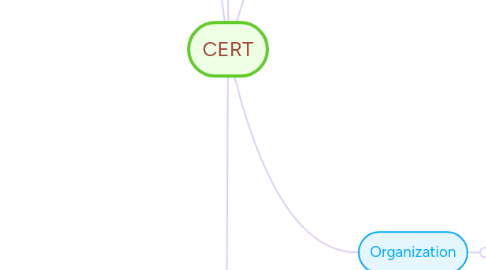
1. Grading Plan
1.1. Final exam
1.2. Exercises
1.3. Attendance
2. Required texts and supplies
2.1. CERT Basic Trainng Manual
2.2. Tables and Chairs
2.3. Meeting Room
2.4. Room for Disaster Simulation
2.5. CERT Backpacks/Supplies from FEMA
2.6. Funding from FEMA for Program
2.7. Fire Department Guest Speaker Wk 2
2.8. EMT Guest Speaker Wk 3
2.9. Staff Presenter
3. Evaluation of CERT
3.1. Objectives
3.1.1. Establishing if CERT is a well designed course
3.1.2. Determine if CERT prepares community member participants for crises through: Fire awareness/mitigation & response; medical response; light search & rescue techniques; describe CERT roles; self-confidence to respond in crises-short-term & long-term
3.1.3. Determine if CERT participants are satisfied with the course.
3.1.4. Determine if Emergency personnel are satisfied with the course.
3.1.5. Determine if CERT's objectives are met at the end of the course/Participants perspective
3.1.6. Determine if CERT's objectives are met at the end of the course/ Emergency personnel perspective.
3.2. Risk Management
3.2.1. Time available in OEM schedule for 6 wk course
3.2.2. Funding/Support/Supplies available from FEMA
3.2.3. Resources available: Meeting room; tables; chairs; simulation room; Staff to facilitate; Fire Personnel available/ EMT personnel available; computer/software/power available
3.2.4. Stakeholder bias that would affect success of evalaution
3.3. Assessment techniques
3.3.1. Questionnaire/Participant end of course
3.3.2. Questionnaire/Participant six months later
3.3.3. Questionnaire/Emergency Personnel at the end of course
3.3.4. Questionnaire/Participant at beginning of course
3.3.5. Questionnaire/Emergency Personnel six months later
4. Course Topics
4.1. Unit 1: Disaster Preparedness
4.2. Unit 2: Fire Safety
4.3. Unit 3: Disaster Medical I
4.4. Unit 4: Disaster Medical II
4.5. Unit 5: Light Search & Rescue
4.6. Unit 6: CERT Organization
4.7. Unit 7: Disaster Psychology
4.8. Unit 8: Terrorism
4.9. Unit 9: Course Review/ Final Exam/ Disaster Simulation
5. Course Objectives
5.1. Objective 1: Describe hazards that affect: homes/workplaces/neighborhoods.
5.2. Objective 2: Take steps to prepare self & families for a disaster.
5.3. Objective 3:Describe functions of CERT and role in response.
5.4. Objective 4: Identify/reduce potential fire hazards in: Homes/workplaces/neighborhoods.
5.5. Objective 5: Apply team work in: fire suppression/resources/ safety measure in fire scenarios.
5.6. Objective 6: Apply emergency medical techniques: open airways/control excessive bleeding/treat shock.
5.7. Objectives 7: Conduct triage under simulated conditions
5.8. Objective 8: Perform head-to-toe assessments
5.9. Objective 9: Select & set up treatment area.
5.10. Objective 10: Employ basic medical treatment: various injuries/splints/sprains.
5.11. Objectives 11: Identify planning/analyzing techniques for search & rescue.
5.12. Objectives 12: Describe common techniques for searching a structure.
5.13. Objectives 13: Team work applying safe techniques for debris removal/victim extrication.
5.14. Objectives 14: Describe protection for rescuers during search & rescue.
5.15. Objectives 15: Describe post-disaster psych environment/steps to relieve own stress and disaster victims.
5.16. Objectives 16: Describe CERT organization/documentation procedures
6. Organization
6.1. Lectures
6.1.1. CERT Staff- wks 1-9/Fire Personnel-wk 2/EMT-wk 3
6.2. Exams
6.2.1. Final written exam in manual- wk 9
6.3. Exercises
6.3.1. Perform working a fire extinguisher-wk 2
6.3.2. Team work building a tower-wk 1
6.3.3. Demonstrate medical techniques: open airway/control bleeding/treat shock/triage-wk 3
6.3.4. Demonstrate Head-to-toe Assessment medical-wk 4
6.3.5. Disaster Simulation - wk 9
